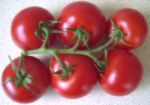The comparison between the pot grown tomato and those in the ground.
I grew 2 varieties this year moneymaker and an Italian cherry tomato variety. I cannot remember the name but they came free with a magazine. I sowed the seeds in March 2008 and grew them on in my conservatory in 6 inch pots. As Always I grew too many tomato plants and gave 20 away. I planted them out as 2 - 3 foot high plants in early June and a month later picked the first tomatoes. As I speak in late august I still have many fruits to pick so it has been a good year. The plants grown in containers have had similar results but I have noticed 2 differences.
Firstly the moneymaker tomatoes were slightly smaller than the ones grown on my plot.
Secondly there were not quite as many cherry tomatoes in the containers.
Other than that the results were very similar. The taste is uniformly excellent and the texture and colour very appetizing. For the container grown tomatoes I did treat them differently and with a bit more care.
1. Make sure you put tomato plants in a really big pot.
I like the root systems to have plenty of room and not become pot bound. You also need a big container to have enough depth for the support canes. I use standard clay terracotta pots but any wide and deep container will work fine.
2. Water your tomatoes even if it rains.
We have had a dreadful summer in the UK this year and it has rained constantly. I still found that the pot grown tomato plants were wilting a bit if I didn't check them for watering. The plants in the veg plot did not need this. The reason for this is that the leaves of the tomato plants deflect much of the water away from the pot. Very little water gets to the root of the plants. This is why I check them daily.
3. Be ruthless with pinching out side shoots on the tomato plants.
I only pinch out once or twice a season when growing tomatoes in the ground because they seem to do fine. I have learned this through trial and error. The moneymaker plants in pots were pinched out once a week to ensure that the fruits I did get were big enough and juicy enough. I never bother pinching out cherry tomatoes. They take care of themselves and always give plenty of harvest.
4. Remove excess foliage once you have the tomato fruits.
I have always done this to tomatoes and do not know where I picked this tip up. Once you have all the tomatoes set on the plant remove any leaves that are hiding the fruit from the sun. I prefer the tomatoes to ripen on the plant and this helps speed up the ripening process. Removing the leaves also gives you slightly bigger tomatoes.
If you have missed this tomato season then I encourage you to plan ahead for your tomato growing in 2009. Grow some in pots and containers as well as in the ground. They are a lot of fun and be grown on any sunny spot you have.
About the Author
You can grow plants in containers very easily and without a large garden. Tomatoes are particularly suitable for growing in containers. For more gardening tips you can visit www.your-gardening-tips.com






